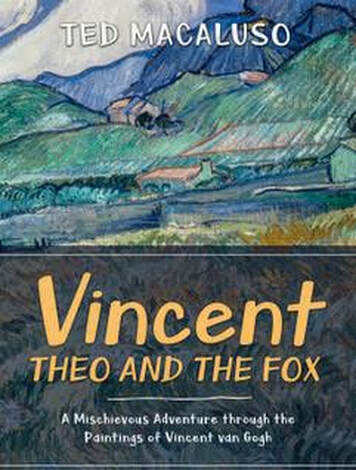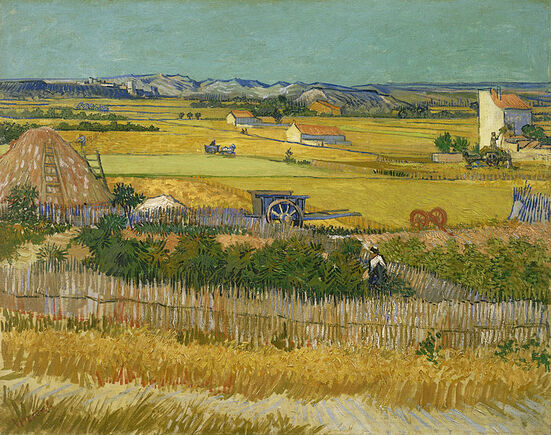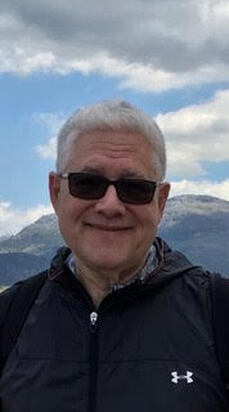|
Carol Scheina sat down to talk with children’s author Ted Macaluso, on behalf of The Ekphrastic Review. Ted is the author of Vincent, Theo, and the Fox, which weaves a fantastical story of Vincent Van Gogh through the artist’s works. Ted talked about his experiences in writing the book, and how he used ekphrastic writing to capture the magic he finds in Van Gogh’s paintings as well as to capture the imagination of children. Carol: Can you give a little bit about your background? Ted: I grew up 20 miles north of New York City, and my mother was very artistic. In fact, she became a sculptress later in her life. As a result, I think I visited every museum in New York City at least 20 times before I had gotten to high school. I’ve never had formal art training or taken art history classes, but I’ve had this love of art my whole life thanks to my mother. Where I grew up, we lived on a hill, and there was a place I could walk to where I could look into a valley, much like Harvest at La Crau, which I used with the opening of my book, Vincent, Theo, and the Fox. I would go there a lot just to get away to think. And that may be why I resonated with Harvest, because I had the idea of a boy stopping at a lookout point to think and observe. In terms of writing, I had lots of experience writing nonfiction. I taught political science at the University of Kentucky, and later did research and evaluation studies for the Food and Nutrition service in the government. Writing fiction is a second career. I started taking courses at the Writer’s Center in Bethesda, Maryland, and I’ve been working on it ever since. What originally drew you to Van Gogh's paintings? I was drawn to the paintings Van Gogh did after Paris, where he has all of this colour and the expressionism. When I look at his paintings, I feel suspended between reality and something else, something more. That feeling comes from things like angles being not quite right. For instance, if you look at The Church at Auvers, it looks very close to the real church, but the angles are off and there’s no doorway into it. It’s real but not real. In Starry Night, he uses colours that contrast in a way that makes it look like the stars are moving. All of that drew me to his art; I just loved it. What inspired you to write a children’s book about the paintings? The story began about two decades ago with my son, Mark, who at age five had asthma and had to use a nebulizer machine. Mark had to sit still at the dining room table during his treatment, and one afternoon when he was receiving treatment, he wanted me to read him a children’s story. All the children’s books were elsewhere, and the only book nearby was a catalog from the National Gallery of Art about a Van Gogh exhibit they had recently had. Mark insisted that I read the catalog to him. I found the painting, Harvest at La Crau, it just seemed to me that a young boy, such as Vincent, and his brother could sit there above the fields and talk. That became the start of the story. The cart in the middle of the picture, which is the focal point of the image, is fascinating. I wondered if farmers could store their lunch there, and if you have lunch, an animal like a fox could go after it, and if he did, he’d get into trouble. Thus, I had three characters: the fox and two boys, the beginning of a plot, and a reason to move on to another picture. That day, I made up a really disjointed story, but Mark loved it. He wanted me to write it down, and then, I wanted to do it really right. That grew into a process of thinking about what makes for a good story and looking at lots of Van Gogh paintings. I would flip back and forth through paintings, thinking about them from a story perspective. Who is this fox? I thought, well, he’s young like Vincent and Theo. He is new in the world and wants to find things out. He’s curious, and he therefore is going to try things like Vincent did. And also, he’s hungry. And so, I thought that sounded like the start of a story. Often, something in a painting would send the story in a new direction. Then I realized the fox was young and didn’t know what he was going to do, so new story directions were fine. Just like any kid, he would have to figure out life. I think a lot of kids can relate to that theme, and that question of what am I going to be when I grow up. Why did you feel inspired to use a fox in your story? The fox just came to me; I didn’t analyze it much at the time. I wanted to use an animal rather than a person because it was for kids, and it would be interesting. My subconscious knew I needed an animal that would be plausible in the French countryside, so I couldn’t have a cute cuddly panda bear. It also had to be a wild animal, therefore dogs and cats were out, and so I picked the fox. Also, there is no fox in any of Van Gogh’s paintings. You cannot find one, so the readers need to use their imagination to put the fox in those scenes. As soon as you look at the paintings, they all open up different things. For example, when they were going through the woods, you can wonder, is the fox behind a tree in the painting? How did the fox get through? I like the way that you can look at one of the paintings and imagine a fox walking up the street. It was a very interesting journey writing this. You blended a bit of Van Gogh's real-life history, his paintings, and an imagined storyline. How familiar were you with Van Gogh's life beforehand, and did that help inspire your story? I was broadly familiar with Van Gogh, but not an expert. I realized that I was writing about a real person, so it had to be realistic. I couldn’t contradict his real life, so I did a lot of reading and research. I think that’s important, because if you’re drawing inspiration from artwork, your imagination can run to many places. Since this was a real person, I couldn’t have the story contradict the events in his life. Van Gogh tried a lot of different careers. He didn’t settle on painting until he was in his late 20s. He tried all these different careers. I had the fox in my story do the same thing, try lots of different experiences. Van Gogh was always searching for something in life, so my story parallels that in that the children reading it can also have a quest through his pictures. Do you feel this story will help Van Gogh resonate with children? How do you feel ekphrastic writing resonates with children? I hope so. Some of the reviews I’ve had say that their child loved the story, and guessed where the fox might be on every page. I do think ekphrastic writing is right for kids because that’s how so many of them look at the world. They look at what’s around them, and especially at artwork, and make up stories to explain it or interpret it. They’re not confined by the barriers we create as adults, or that are forced on us as adults. I think ekphrastic writing is one way for adults to become childlike again, to free their imagination. Do you have plans for future ekphrastic books for children? I’m working on a young adult novel right now inspired by a Russian painter, Ivan Aivazovsky. He isn’t well known in the United States, but he was very famous in Europe, and he made hundreds of paintings. He was the official painter for the Russian navy. His paintings just grabbed me when I saw them. It’s just this romantic adventure world, sort of like Treasure Island. I’ve also been working on a children’s book, Seeking Cezanne, which is similar to my Vincent book. It’s aimed at kids, and it involves the art of Cezanne and some other artists as well. Was there one painting that resonated with you the most while writing this story, and why? There are three, actually. Harvest at La Crau is the very first one. It started the story, Vincent, Theo, and the Fox, and as I said, maybe because I grew up on a hill, I could just picture Vincent and Theo being there. Looking at that field and at the blue cart that’s the focal point. It’s oversized, it’s so big, it doesn’t look real. And doesn’t it make you want to explore it, the way it draws you into it? It’s just mysterious because you have an oversized cart, you have something that looks like a very beautiful pastoral scene but next to the cart, there are wheels for a different cart that are almost like day-glow orange. They look like they’re just burning with some otherworldly light. You’re also looking at the fields, and they’re all geometric and regular. That image always stuck with me. I resonated with Wheat Field with Crows, which is one of his most famous paintings and is featured as a two-page spread in my book. I love how expansive it is, and it’s just a beautiful portrayal of darkness and light. It has a trail on the left approaching the viewer, then curving away, symbolizing life and death and the human journey, or the joy of being outdoors in the field. The third painting is Starry Night. I’m not the only one who thinks it’s genius, but it really is genius. In person, it’s so small you don’t believe it, for it looms so large in the public’s consciousnesses. I didn’t know this when I chose it, but the stars emulate fluid dynamics. He used colours that complement each other in such a way that your eye thinks they’re moving. They’re just mystical and living. You have the comfort of that sleepy little village, which contrasts with the church that’s completely dark. Its spire ends in one of the few black points in the sky. But you still have the stars to tell you that there is a God. What’s more, it has flowing hills, and the hills were very important when crafting my book because I figured that’s where a fox could be. I had to end the story with that painting because the fox is free and Vincent is happily dreaming that the fox is running wild and free under a starry sky. That aspect of both wild and free, I think, was perfect because that’s the perfect end for the fox, and it also sort of describes Vincent’s artwork. His work was really wild for his time, and he broke conventions. I view many of Van Gogh’s paintings as seeing the magic just beyond what you’re looking at. Vincent: Theo and the Fox by Ted Macaluso Owls Cove Press, 2019 Click here to view or purchase. ** Carol Scheina is a speculative fiction author who also works as a technical editor in the Washington, D.C. suburbs. Her short stories have appeared in Escape Pod, Daily Science Fiction, The Arcanist, and other publications. You can find more of her work at carolscheina.wordpress.com.
1 Comment
michael balk
11/1/2021 10:50:21 pm
hey ted, i remember your mother visiting our classroom several times and she was always very warm, gracious, and accepting... this struck me as quite an unusual and positive experience-something unaccustomed to me and my milieu....at that point. regarding "kids' books" i recently read "my life in dog years" by gary paulsen... also his "iron rode road" tale of his harley adventure at age 57 to fairbanks and back to his home in new mexico... his u-tube interview is well worth viewing, i feel... i plan to look up your published work... maybe its in my local library now that libraries are finally reopening....be well, michael balk
Reply
Your comment will be posted after it is approved.
Leave a Reply. |
The Ekphrastic Review
COOKIES/PRIVACY
This site uses cookies to deliver your best navigation experience this time and next. Continuing here means you consent to cookies. Thank you. Join us on Facebook:
July 2024
|






